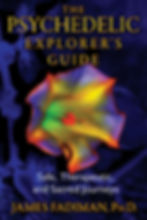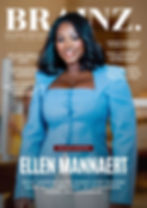Interview With Psychedelic Researcher James Fadiman About The Creative Process
- Brainz Magazine
- Oct 31, 2022
- 5 min read
Ronald Alexander, PhD, has a private psychotherapy and executive coaching practice in Santa Monica, California. He’s the executive director of the OpenMind® Training Program that offers personal and professional training programs in mindfulness-based therapies, transformational leadership, and meditation. He is author of the new book, Core Creativity: The Mindful Way to Unlock Your Creative Self, and also of the highly acclaimed Wise Mind, Open Mind: Finding Purpose and Meaning in Times of Crisis, Loss, and Change (2009).
James Fadiman, PhD, is known as America’s wisest and most respected authority on psychedelics and their use. He has been involved with psychedelic research since the 1960s. His book, The Psychedelic Explorer’s Guide (2011), addresses the immediate and long-term effects of psychedelic use for spiritual, therapeutic and problem-solving purposes. Fadiman has examined how psychedelics, used wisely, can lead not only to healing but also to scientific breakthroughs and spiritual epiphanies.

You’re the forefather of the microdosing movement in recent worldwide psychedelic usage. Can you share how you became involved in this part of the spectrum of current day psychedelic usage?
About 12 years ago I was introduced to the idea of microdosing. I was told that Albert Hoffman would take a microdose and think while walking in the woods. I found that microdosing had a gentle positive effect. I shared that information, got more and more curious, and did the first research study that showed it had a number of possible uses. I haven’t stopped discovering those uses ever since.
I’m one of the founders of the International Microdosing Association and I have looked especially at applications for well people. That aspect is more and more popular and encourages people to be more creative, more focused, and healthier. It’s good to remember that you don’t have to be sick in order to be better. It has been a totally surprising adventure.
When you were doing research at Stanford, what did you learn about how psychedelics could enhance one’s creativity?
The last psychedelic research project I did while at Stanford looked at the question: Could an altered state brought on by taking a psychedelic be focused away from personal issues or visionary experiences towards practical scientific concerns, and could a person focus even more closely on the solution of hitherto unsolvable problems? That it worked as well as it did and that all our subjects were senior scientists throughout Silicon Valley may have done much to seed the psychedelic subculture that followed.
As Steve Jobs would tell you, and Bill Gates would never admit to, psychedelics were important to both men. What they did with their own consciousness changed the world.
The creativity of the ´60s, fueled in part by psychedelic experiences, helped foster the ecology movement, the social justice movement, and the women’s movement, and, to the consternation of a lot of elements of the establishment, the anti-war movement. Psychedelic research was shut down for political reasons, which allowed an enormous amount of unnecessary suffering to continue.
My recently published book, Core Creativity: The Mindful Way to Unlock Your Creative Self, has a section on microdosing and creativity. You were the seminal contributor to the section and assisted me in fleshing it out with more depth, accuracy, and breath. Can you share your thoughts from the field about how psychedelic microdosing can contribute to enhancing one’s core creativity?
I have few opinions on this topic, but a huge number of reports of how people’s capacity to see things differently expands when they are microdosing. In an area like machine design, for example, people can see more of the parts moving in different directions in their minds while microdosing. What’s most common is people reporting an enhanced capacity to remain in “flow” far longer and therefore move more quickly through the initial creativity necessary to do an art form or to invent a new and better method of research. It’s as if they have more control over where their mind goes and have greater energy while in a creative state. They may not reach new heights of creativity, but they make better use of their own capacities than they seem to have been able to do before.
You’ve been married for decades to Dorothy, a filmmaker and a core creative. What sorts of habits do both you and Dorothy employ to work through when either one of you is feeling blocked in making a film or writing a book or article?
Dorothy and I have remarkably different creative styles, especially at the beginning of a project. She will look at a problem or a wonderfully successful operation or institution and have a vision of how the core of that issue or that success could be made visual. It’s more of a feeling then an image and gradually it becomes imagery and eventually a film. Her range is amazing: from a film about a local fixit shop to a film about how the American voting system has become corrupted.
I tend to have an idea, a notion, even a speculation that something might be possible or true. I tend to explore it in words. Some of these turned into a play set in Renaissance Italy, a novel about the CIA running a house of prostitution in San Francisco and secretly giving high doses of LSD to military people passing through (true story), the creation of a Graduate School devoted entirely to transpersonal psychology, and more. I don’t remember either of us ever feeling blocked, but often, incredibly frustrated for sure, which goes with the territory. Usually, time in nature and, more recently, being reminded of the present moment by our two small dogs, seem to be all we need.
You’re in your 7th decade and have always had a wonderful aspect to reinventing yourself. How has creativity been a topic of interest in the foreground or background for you in your work and life?
Eighth decade actually. During my seventh, my work life focused around discovery after discovery related to microdosing psychedelics and consulting to a wood pellet factory and an electric bus company. I wouldn’t call writing a leisure activity, but I did finish a long novel about Eleanor of Aquitaine who was married to the king of France and later the king of England, had nine children including Richard the Lionhearted, went along, against her husband’s wishes to one of the Crusades, and all in all was an amazing character to build a story around.
I’m insatiably curious about plants, about people, about planets. I don’t ever remember starting a job that I was qualified for. The creative part was figuring out what needed to be done and what no one else was doing. I’m of the school that it’s hard not to be creative. Every time you write a letter that makes another person smile, that you cook a new food, that you discover a new author or artist, and that you realize that you’ve just thought of something you’ve never thought of before you are being creative. We enshrine creative product.
I’m much more aware, especially as I’ve gotten older, of creative process. One nice thing about process is there’s no element of competition in it. Doing it is always a success.
Thank you so much for sharing your thoughts.
Thank you for inviting me to be with you.
Learn more about core creativity at www.CoreCreativity.com.









